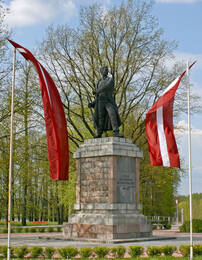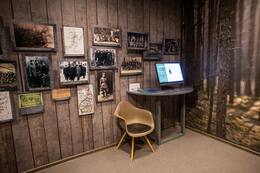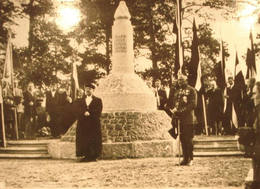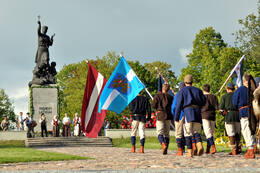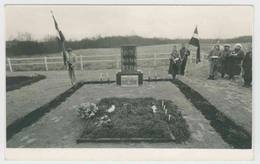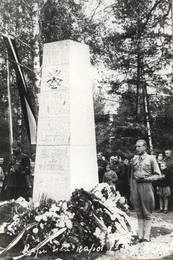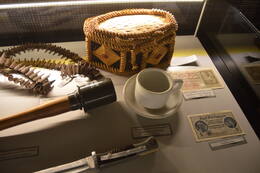Partizaninė veikla Šiaurės Latgaloje
I Nepriklausomybės karai
Pirmieji latgaliečių partizanų išpuoliai prieš sovietų Latvijos armiją prasidėjo jau 1919 m. kovo mėn. Gegužės mėnesį Kupravoje, Rugajuose ir kitose vietose buvo suformuoti keli kariniai daliniai po apie 30 vyrų. Gegužės 29 ir 30 dienomis partizanų daliniai puolė sovietų Latvijos armijos dalinius, atvykusius iš Šiaurės Vidžemės per Balvius. Birželio 15 d. bolševikų šarvuotasis traukinys sugebėjo užimti Kupravos stotį, o birželio 21 d. bandė pakartoti puolimą Balvių stoties kryptimi. Partizanai kartu su maždaug 100 estų kareivių apsupo traukinį ir privertė jį trauktis Pytalovos kryptimi. 1919 m. vasarą partizanai, remiami estų kareivių, užėmė Liepną ir Balvius.
1919 m. liepos 5 d. Balvuose vykusiame susirinkime partizanų grupių atstovai nusprendė susijungti į vieną pulką, o liepos 7 d. partizanų grupės įkūrė Latgalos partizanų pulką, vadovaujamą leitenanto Jānio Vīndedžo (1892–1926). Iš pradžių partizanų pulke buvo keturios kuopos. Nuo liepos 13 d. pulkas perėjo Kuržemės divizijos vado žinion. Liepos 28–30 d. vyko mūšiai prie Baltinavos ir prie Punduri stoties, buvo užimta Viljaka. Po mūšių prie Stompaki ir Susajų iš vietos partizanų buvo suformuota 5-oji pulko kuopa. Rugpjūčio 9 d. iš Liepnos partizanų divizijos buvo suformuota 6-oji kuopa, kuri rugsėjo 22 d. užėmė Liepną. 1919 m. spalį partizanų pulkas išaugo iki 2000 vyrų, todėl jis buvo reorganizuotas ir suformuoti trys batalionai su 8 kuopomis, o ketvirtasis batalionas – iš 9-osios kuopos. Spalio 4 d. pulko vadu buvo paskirtas pulkininkas leitenantas Jānis Skujiņš (1897–1942). Spalio 16 d. 2-asis pulko batalionas užėmė Nostrovą ir Stompakius. Lapkričio 7–9 d. Raudonoji armija pradėjo kontrataką ir atgavo spalį prarastas pozicijas. 1920 m. sausį pulke buvo 49 karininkai ir 2400 kareivių, kurie taip pat buvo ginkluoti kulkosvaidžiais. Pulkas dalyvavo Šiaurės Latgalos išlaisvinimo operacijose 1920 m. sausį ir vasarį.
Nepriklausomybės karo metu Latgalos partizanų pulkas neteko 145 karių. 40 pulko karių buvo apdovanoti Lačplėšio karo ordinu.
1938 m. rugpjūčio 14 d. Balvuose, Brīvības ir Partizānu gatvių sankryžoje, buvo atidengtas paminklas žuvusiems Latgalos partizanų pulko „Sargybos partizanas“ kariams.
Daugiau informacijos šaltinių
Jānis Skujiņš. Latgalos partizanų pulkas. Knyga: Latgalos išvadavimo 15-mečiui atminti. 1920-1935 m. Rezeknė, 1935, p. 32-33; taip pat: http://www.periodika.lv/periodika2-viewer/view/index-dev.html#panel:pp|issue:/g_001_0307061306|straipsnis:DIVL259|puslapis:32|issueType:undefined
Latgalos partizanų pulkas. Vikipedija. https://lv.wikipedia.org/wiki/Latgales_partiz%C4%81nu_pulks
Susijusi laiko juosta
Susijusios vietos
Paminklas žuvusiems Latgalos partizanų pulko kariams 1919–1920 m.
Latvijos Nepriklausomybės karo (1918–1920 m.) metu Balvių krašte vietos gyventojų iniciatyva buvo suformuotas Balvių partizanų skyrius, kuris netrukus buvo pertvarkytas į Latgalos partizanų pulką.
Pulko paminklo idėja kilo dar 1927 m. 1933 m. buvęs Latgalos partizanų pulko kareivis ir akmenkalys Jānis Pilmanis savo lėšomis pastatė 5 metrų aukščio akmeninį paminklo postamentą. Patį bronzinį paminklą sukūrė menininkas Kārlis Jansons.
Paminklas, skirtas žuvusių pulko karių atminimui, buvo atidengtas 1938 m. rugpjūčio 14 d., dalyvaujant generolui Jāniui Balodžiui. Nors oficialus paminklo pavadinimas buvo „Sargybos partizanas“, netrukus žmonės paminklą ėmė vadinti tiesiog „Balva Stanislava“.
Latviją okupavus SSRS, 1941 m. pavasarį Abrenės apskrities vykdomojo komiteto sprendimu paminklas buvo nugriautas. Aukštas postamentas buvo nugriautas, tačiau pats bronzinis paminklas liko Balvų policijos kieme.
Vokiečių okupacijos metu paminklo postamentas nebuvo restauruotas, tačiau pats bronzinis paminklas buvo pastatytas ankstesnėje vietoje. Po antrojo sovietų okupantų sugrįžimo 1944 m. paminklas buvo visiškai sunaikintas.
Latvijai atgavus nepriklausomybę, Balvų gyventojai rinko aukas Latgalos partizanų paminklo restauravimui. 1993 m. lapkričio 11 d. Balvuose buvo atidengtas restauruotas paminklas, kurį sukūrė menininko Kārlio Jansono sūnus Andrejus Jansonas.
Prie paminklo pjedestalo galo pritvirtinta papildoma atminimo lenta su užrašu „Renovuota taip pat pagerbiant 1940–1954 m. Latgalos nacionalinės laisvės kovotojus“.
Ekspozicija „Šiaurės Latgala kovose už laisvę“ (Ziemeļlatgale brīvības cīņās)
Muziejus įsikūręs Balvų dvaro komplekse, buvusiame dvaro klėties pastate.
Ekspozicija supažindina su Latvijos Nepriklausomybės kovų istorija iš Šiaurės Latgalos perspektyvos, pasakoja Latgalos partizanų pulko kūrimosi ir veiklos istoriją. Čia eksponuojamos anksčiau niekur nepublikuotos nuotraukos ir dokumentų kopijos, įskaitant 1919 m. liepos 5 d. įsakymą dėl pulko suformavimo. Ypatingą ekspozicijos dalį sudaro 1919 m. liepos–spalio mėn. rusų kalba rašyti vidiniai pulko įsakymai. Jie atskleidžia šio vietinio karinio dalinio formavimosi ypatumus – jame kartu kovojo latviai, latgaliai, rusai ir žydai. Tik pulkui tapus visaverte Latvijos kariuomenės dalimi ir jį papildžius mobilizuotiems kariams iš kitų Latvijos regionų, vidiniai dokumentai pradėti rengti latvių kalba. Ekspozicijoje pasakojama apie Šiaurės Latgalos išvadavimo operaciją. 1920 m. sausio 9–15 d. Latvijos kariuomenės Latgalos divizijos vykdytų mūšių metu buvo išlaisvintos Viliakos, Jaunlatgalės ir Karsavos apylinkės. Galima apžiūrėti su šia operacija susijusius eksponatus, įskaitant ir Lat galos partizanų pulko veiklą Karsavos išvadavimo metu.
Paminklas Jaškove Latvijos išsivadavimo kovoje žuvusiems kariams
Įsikūręs kairėje Viliakos–Vientulio kelio atkarpos (P35) pusėje, šalia Jaškovos kapinių koplyčios.
Paminklas Latvijos ir Estijos kariams, žuvusiems Nepriklausomybės kare.
Skulptoriaus Kārlio Zemdegos sukurtas paminklas 1920 m. Jaškove žuvusiems Išvadavimo kare kariams atminti pirmą kartą buvo atidengtas 1935 m. rugsėjo 22 d. Viliakos brolių kapinėse, įkurtose 1929 m.
Laisvės kova prieš Raudonąją armiją Viliakos krašte prasidėjo 1920 m. sausio 9 d., kai Latvijos armija ir Latgalos partizanų pulkas užpuolė miestą. Jose dalyvavo ir Estijos kareiviai. Viliaka buvo išlaisvinta sausio 9 d., tačiau kovos į rytus nuo jos tęsėsi dar kelias dienas. Tiek prieš, tiek po Viliakos išlaisvinimo žuvę kareiviai buvo laidojami įvairiose vietos gyventojams žinomose vietose. Latvijos valstybei stabilizuojantis, pradėta galvoti apie bendrų brolių kapinių įrengimą Viliakoje. Jau 1923 m. lapkričio 18 d., po iškilmingų pamaldų katalikų bažnyčioje, kurias vedė dekanas P. Apšinīkas, didelė procesija patraukė į naujai įkurtas brolių kapines ant kalvos, vadinamuosiuose Jaškovuose – visai netoli Viliakos. Netrukus buvo padėti paminklo pamatai ir pradėtos rinkti aukos paminklui. Žuvusių kareivių kapų identifikavimas užtruko, ir tik 1929 m. lapkričio 3 d. įvyko perlaidojimas būsimose brolijos kapinėse. Jose buvo palaidoti 31 Latvijos ir 14 Estijos kareivių, žuvusių Viliakos apylinkėse. 1935 m. paminklas buvo paruoštas ir iškilmingai pašventintas rugsėjo 22 d.
Iki karo Latvijos nepriklausomybės metais visi svarbūs nacionaliniai įvykiai Viljakos parapijoje buvo susiję su brolių kapais ir šiuo paminklu.
Paminklas buvo sunaikintas pokario sovietmečio metais, tačiau jo granito dalys, nors ir pažeistos, buvo išsaugotos. Paminklas buvo restauruotas 1990 m. lapkričio 11 d. – Lačplėsio dieną.
Paminklas „Vieningi dėl Latvijos“ (Vienoti Latvijai) arba Latgalos Mara
Rėzeknėje stovi paminklas „Vieningi dėl Latvijos“, žmonių vadinamas „Latgalos Mara“. Pagrindinė figūra – moteris su kryžiumi rankoje – simbolizuoja 1920 m. iš bolševikų valdžios išvaduotą Latgalą ir jos krikščionišką dvasią.
Paminklo idėja gimė XX a. 3 deš. pabaigoje, ją inicijavo Latgalos visuomenės veikėjai. 1930 m. birželio 8 d. buvo pašventintas pirmasis paminklo pamatų akmuo. 1934 m. birželį buvo paskelbtas konkursas, kurį laimėjo Karlio Jansono projektas. 1939 m. rugsėjo 8 d. paminklas iškilmingai atidengtas. Pašventinimo apeigoms vadovavo vyskupas Jazepas Rancanas.
Sovietų okupacijos laikotarpiu, 1940 m. lapkritį paminklas buvo nugriautas. Bronzinės skulptūros sunaikinti nespėjo, todėl vokiečių okupacijos metais, 1943 m. rugpjūčio 22 d. paminklas buvo atstatytas. Grįžus sovietų okupacijai, iš pradžių buvo nupjautas kryžius, o 1950 m. paminklas visiškai sunaikintas.
Jo vietoje buvo pastatytas Lenino paminklas, kuris buvo nugriautas iškart po Latvijos nepriklausomybės atgavimo 1991 m. Atgimimo laikotarpiu, 1989 metais, kilo idėja atkurti istorinį paminklą „Vieningi dėl Latvijos“. Paminklą, remdamasis savo tėvo medžiaga ir nuotraukomis, atkūrė Karlio Jansono sūnus skulptorius Andrejus Jansonas kartu su Inta Folkmane. Atnaujintas paminklas buvo atidengtas 1992 m. rugpjūčio 13 d. per Pirmąjį pasaulinį latgalių susitikimą.
Žaliųjų partizanų atminimo akmuo
Įsikūręs Ērgliuose, Parko ir Saules gatvių kampe, netoli geležinkelio viaduko.
1919 m. gegužės 23 d. žalieji partizanai puolė bolševikų vežimų koloną Ērglių centre. Mūšis truko dvi valandas, partizanai paėmė į nelaisvę 78 arklius ir daug vežimų su šautuvais ir kitais daiktais. Mūšyje žuvo keturi partizanai, vienas buvo sužeistas. Iš viso regiono partizanų gretose kovojo 61 vyras, iš kurių žuvo šeši.
1939 m. gegužės 21 d. Ērglių kaime 121-asis Ērglių mažasis pulkas pastatė paminklinį akmenį toje vietoje, kur 1919 m. gegužės 23 d. žuvo Žalieji partizanai Jānis Andriksonas, Andrejus Bumbers, Kārlis Baņģieris ir Jānis Gūts.
Sovietų okupacijos metu Parko ir Saulės gatvių sankryžoje stovėjęs memorialas buvo nugriautas. Jis buvo restauruotas ir vėl pastatytas 1989 m. balandžio 22 d.
Viliakos muziejus
Viliakos muziejus įsikūręs dviejuose pastatuose – 1913 m. statytuose miestelio kultūros istorijai svarbiuose katalikų parapijos namuose ir buvusiame kapucinų vienuolyne, kurio rūsiai glaudžiai susiję su nacionalinių partizanų judėjimu Stompakuose ir sovietų čekistų veikla. Žmonės prisimena, kad šiuose rūsiuose buvo laikomi ir kankinami žmonės. Senajame muziejaus pastate įrengtos kelios ekspozicijos. Viena jų pristato 1920 m. laisvės kovas Šiaurės Latgaloje, Antrojo pasaulinio karo įvykius – žydų holokaustą Viliakoje ir informaciją apie sušaudytas šeimas. Daugiau apie kiekvieną šeimą galima sužinoti pagal gyvenamosios vietos adresą.
Ekspoziciją papildo informacija apie nacionalinių partizanų judėjimą Stompakuose – įvairūs eksponatai: nuotraukos, daiktai. Muziejaus lankytojai gali susipažinti su karinio paveldo vietomis Viliakoje ir jos aplinkinėse vietovėse, pavyzdžiui, kovotojų už Laisvę paminklu Jaškove, kuris sovietmečiu buvo nugriautas ir atstatytas 1990 m., stela, skirta Lačplėsio karo ordinu apdovanotiesiems. Muziejaus ekspozicijoje girdisi Antrojo pasaulinio karo lėktuvo garsas, kaip priminimas apie netoli Viliakos buvo vokiečių aerodromas „Luftwaffe“. Muziejuje galima susipažinti su prisiminimais apie Antrojo pasaulinio karo įvykius Viliakoje ir gauti informacijos apie vokiečių karo belaisvių stovyklą Račuose.
Susijusi istorija
Šiaurės Latgalos išlaisvinimas nuo bolševikų
1918 m. gruodžio 1 d. Raudonosios armijos daliniai, sudaryti iš raudonųjų šaulių dalinių, įsiveržė į Latvijos teritoriją. Siekdami apsaugoti savo namus, šeimas, gimtąjį kraštą ir išvengti teroro, Balvių apylinkių vyrai griebėsi ginklų ir patraukė į miškus, prasidėjo pirmųjų „žaliųjų“ grupių formavimasis. 1919 m. pavasarį, paskelbus mobilizaciją, daugelis Balvių apylinkių vyrų laikė nepriimtiną kovą sovietinėje Latvijos armijoje ir prisijungė prie „žaliųjų“ grupių. Buvo suformuotos Balvių, Silakrogo, Rugėjų, Teteru-Dūrupės ir Liepnos grupės. „Žaliųjų“ grupių veikla Balvių apylinkėse suaktyvėjo 1919 m. kovo mėn.





